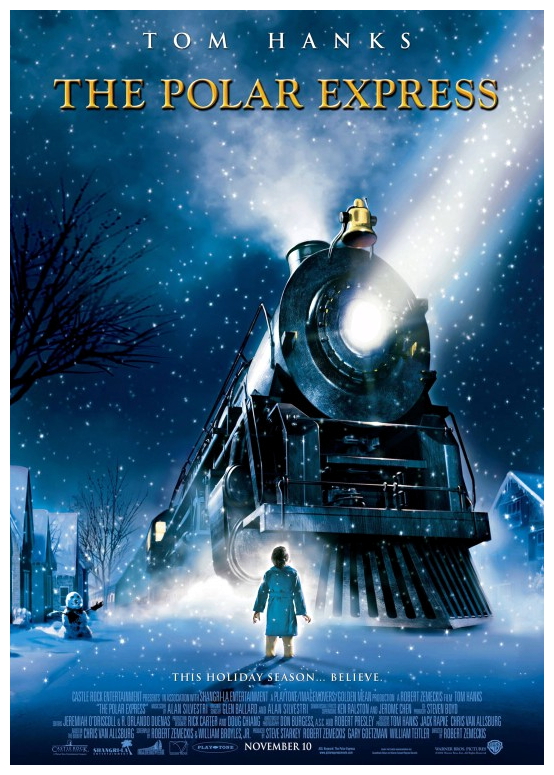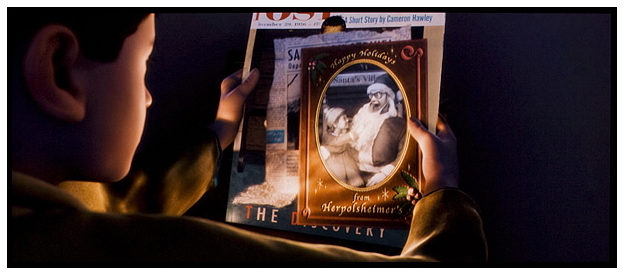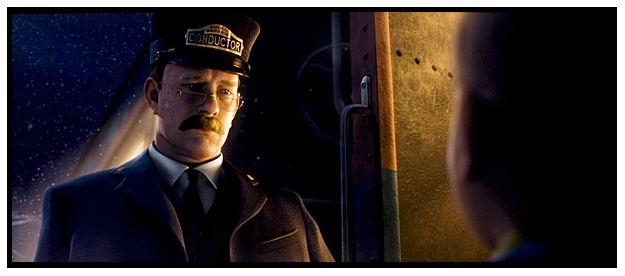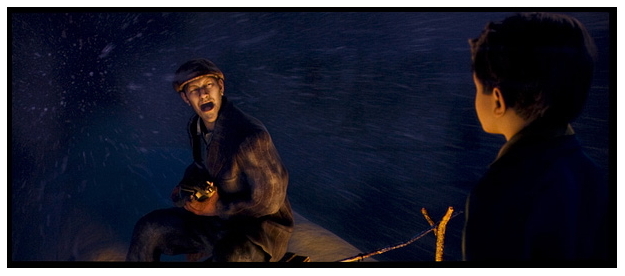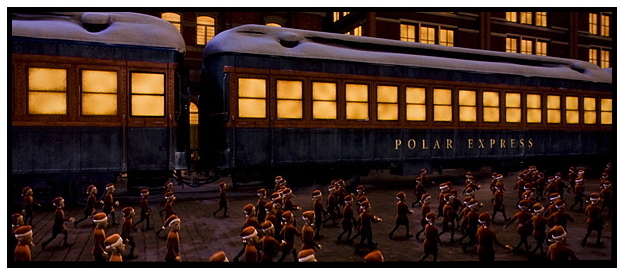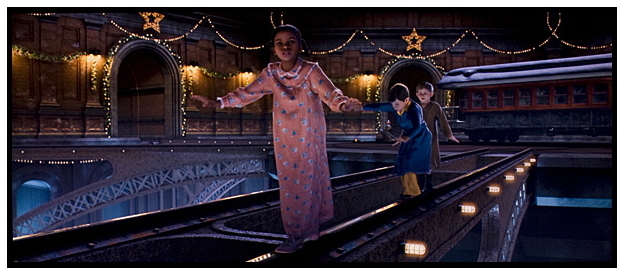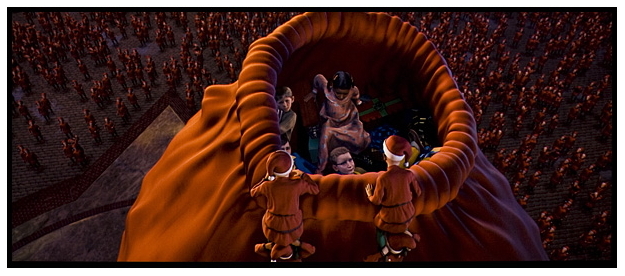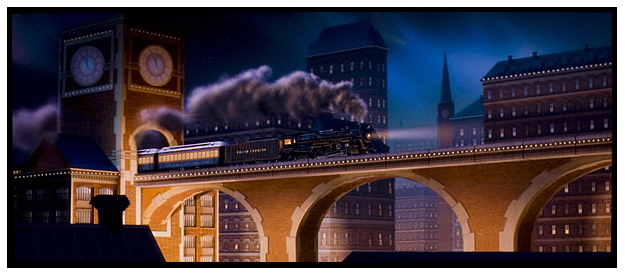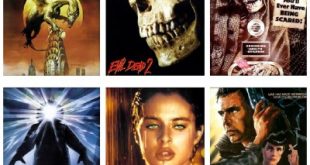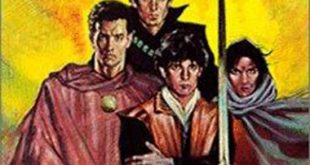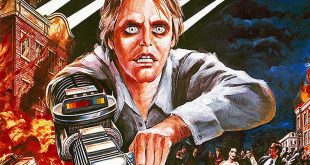SYNOPSIS:
“Santa Claus does not exist. Or does he? For one doubting Boy, an astonishing event occurs. Late on Christmas Eve night, he lies in bed hoping to hear the sound of reindeer bells from Santa’s sleigh. When to his surprise, a steam engine’s roar and whistle can be heard outside his window. The conductor invites him on board to take an extraordinary journey to the North Pole with many other pajama-clad children. There, he receives an extraordinary gift only those who still believe in Santa can experience.” (courtesy IMDB)
REVIEW:
At about a thousand words and fifteen large oil pastel paintings, Chris Van Allsburg‘s book The Polar Express told the tale of a nameless Boy who receives a visit one Christmas Eve from a ghostly locomotive that arrives outside his bedroom window and carries him to the North Pole to meet Santa Claus. Rendered in a lush romantic style accompanied by simple, elegant prose, the story told how the fantastic journey helped the Boy face his growing suspicion that there is no Santa. The slender tome sold more than five million copies, won the 1986 Randolph Caldecott Medal for the most distinguished American children’s picture book. Both Warner Brothers Studios and Castle Rock Entertainment investigated developing the material as a live-action film to be directed by Rob Reiner, but the project was quickly dismissed. Perhaps too quickly.
It became a favourite bedtime story for many children and their parents, including actor Tom Hanks who, in 2000, presented a copy to filmmaker Robert Zemeckis with a Post-It note attached: “Can you do anything with this?” Zemeckis took an immediate liking to both the concept and the slight storyline: “That’s what I love about it. It’s a clean canvas. I can do whatever I want!” With Hanks and Zemeckis attached, the project took shape in another form. Instead of a purely live-action adaptation, Zemeckis sought to bring Van Allsburg’s book to life using digital animation and integrating Hanks’ performance. All the physical performances were to captured digitally, and all the children’s roles were to be acted by adults using oversized props to get the movement right. The Polar Express (2004) is now listed in the Guinness Book of World Records as the first all-digital motion-capture film.
The opening of the film drifts through a snowbound street at night, one of several hundred moving matte paintings. Waking up in his bed, the Boy (Daryl Sabara) steps from his house into a world full of snowflakes (the name of the Boy is never mentioned in the film but, according to several official sources, the Boy’s name is Chris, named after the author). One of the most complex characters seen in the film is revealed in a pall of steam and engine smoke: Four carriages, observation car, locomotive and coal tender that is the Polar Express (based on the Pere Marquette 1225 locomotive, for all you trainspotters out there. In fact many of the train’s sound effects are recordings of the actual train). When the Boy examines the engine, the Conductor (Tom Hanks) lets him board the train. Once on board the train, the Boy encounters a carriage full of children, including a Girl (Nona Gaye) and a Know-It-All kid (Eddie Deezen, who talks so fast he probably has more dialogue than Hanks).
When the train picks up Billy (Peter Scolari, Hanks’ co-star from Bosom Buddies), it transports the children out of the town through a moonlit forest, where wolves prowl the trees. The Conductor summons several waiters to give the children hot chocolate, and the Girl keeps a second cup under her seat to give to Billy, who is alone in the observation car. While the Girl and Conductor deliver the cup to Billy, the Boy discovers the Girl’s ticket is unpunched, but loses it. In a whirlwind sequence, the ticket blows away and takes a circuitous journey through the woodland environment. After the ticket is abused by the wind and animals, it slips back into the train. The Girl explains her lost ticket, and the Conductor considers ejecting her before taking her for a walk on the top of the train instead. The Boy then locates the lost ticket and pursues them.
In his attempt to reunite the lost ticket with its owner, the Boy clambers across the roof of the speeding train where he meets a Hobo (Tom Hanks) playing the Christmas carol Good King Wenceslas. The campfire on the roof of the train carriage reveals the Hobo through the snow, illuminating the character as a sinister and otherworldly apparition who claims to be the owner of the train and King of North Pole. The Hobo directs the Boy to follow behind him and helps him reach the engine before they make it to Flat Top Tunnel, thus allowing him to find and help his friend (the Hobo is a representation of the Holy Spirit and guides those who believe in Him to safety, even in perilous times). The boy jumps into the engine’s coal tender and finds the Girl driving the train while engineers Steamer (Michael Jeter) and Smokey (Michael Jeter) replace the train’s headlight.
After a number of perilous adventures the train finally reaches the North Pole, and the kids begin to form lines while the Boy and Girl find Billy depressed and alone in the observation car. The trio explore the city’s industrial areas until they fall into a pile of presents designated for delivery. The elves remove the kids and, as the reindeer are prepared, Santa Claus (Tom Hanks) arrives. One bell breaks loose from the harness, and the Boy retrieves it. Santa gives the bell to the Boy saying it’s the first gift of Christmas. Santa leaves with his reindeer while an Elvish rock band (led by Aerosmith’s Steven Tyler) plays in celebration, then the children prepare for their return trip home. Santa’s reflection can be seen in the sleigh bell for just a few seconds, when it is shown in close-up, after the Boy places the bell on the table. The narrator ends the story by saying the bell only rings for those who truly believe.
Robert Zemeckis obviously had a lot of fun making The Polar Express and makes several references to his previous films, particularly the Back To The Future (1984) trilogy, including dialogue, scenery and effects. In one scene an elf describes a bad little boy in New Jersey named Steven who terrorises his two little sisters, a reference to producer Steven Spielberg, who grew up in New Jersey and frequently scared his two younger sisters. Composer Alan Silvestri had also done the soundtrack for Reindeer Games (2000), and recycles several key notes. There’s also many references to Charles Dickens‘ novel A Christmas Carol. Like Scrooge, the Boy no longer believes in Santa Claus, causing the three ghosts of Christmas (Hobo, Conductor, Santa) to change him forever. The Hobo is the Ghost of Christmas Past, and tries to intimidate the Boy into changing his ways using only himself instead of the future. The Conductor is the Ghost of Christmas Present and is in charge of keeping order while delivering the Boy to Santa. Finally, Santa is Christmas Future and changes the Boy forever, just as Scrooge was.
There’s also the less-than-obvious Biblical references invoked by The Polar Express. Tom Hanks voices many of the characters even if his likeness is discernible only as the Conductor. He also voices both Santa Claus and the mysterious Hobo. The Hobo is suggested as being a spirit when he asks the Boy if he believes in ghosts, but a deleted scene found on the DVD verifies that the Hobo is indeed a ghost. The multiple roles of Hanks are not simply an artistic choice but they intentionally constitute some symbolic undertones in the plot. Santa Claus, the Conductor and the Hobo represent the Holy Trinity and the trip to the North Pole is a test of the Boy’s faith since he expresses some doubts about the existence of Santa Claus (who represents God). The Conductor represents Jesus Christ, who continually tries to keep the children inside the train and ensures that the locomotive will not deviate (meaning that he guides Christians to the right path). Finally, the Hobo represents the Holy Ghost due to the fact that he is a spirit who guides the Boy by continually testing his faith and giving him options.
The simultaneous worldwide theatrical release and Imax 3-D presentation of The Polar Express elevated the film to the scale of an event that, for many, heralded a new form of animated film. Effects artist Jerome Chen: “It is a new genre and, as a genre, it won’t be appropriate for every kind of movie. I don’t think we’ll be seeing performance capture used for remaking My Dinner With Andre (1981), but I’m hoping that it opens up other types of movies, giving filmmakers a new avenue to explore.” Like most experimental films to come out of Hollywood, critics were polarised: Rotten Tomatoes: “Though the movie is visually stunning overall, the animation for the human characters isn’t lifelike enough and the story is padded.” Roger Ebert: “There’s a deeper, shivery tone instead of the mindless jolliness of the usual Christmas movie. It has a haunting, magical quality. It’s a little creepy. Not creepy in an unpleasant way, but in that sneaky, teasing way that lets you know eerie things could happen.” Richard Roeper: “It remains true to the book, right down to the bittersweet final image.” James Berardinelli: “A delightful tale guaranteed to enthral viewers of all ages.”
There was also some controversy concerning the actual animation process and lifelike characters approaching the infamous ‘Uncanny Valley’. Peter Travers: “A failed and lifeless experiment in which everything goes wrong.” Stephanie Zacharek: “I could probably have tolerated the incessant jitteriness of The Polar Express if the look of it didn’t give me the creeps.” Geoff Pevere: “If I were a child I’d have nightmares. Come to think of it, I did anyway.” Paul Clinton: “At best disconcerting and, at worst, a wee bit horrifying.” In retrospect, only a decade later, The Polar Express has become choice Holiday viewing, already regarded by many as a Christmas classic. I’ll leave you with that thought in mind, to bid you a good night and ask you to return next week with a stout heart, an iron stomach and a titanium bladder for another head-melting romp through the garden of unearthly delights known as…Horror News! Toodles!
Polar Express (2004)
 Horror News | HNN Official Site | Horror Movies,Trailers, Reviews
Horror News | HNN Official Site | Horror Movies,Trailers, Reviews
